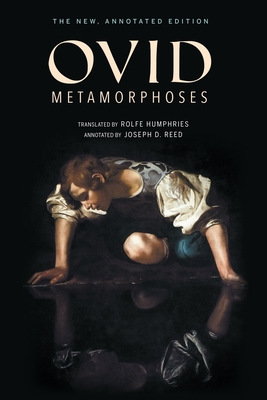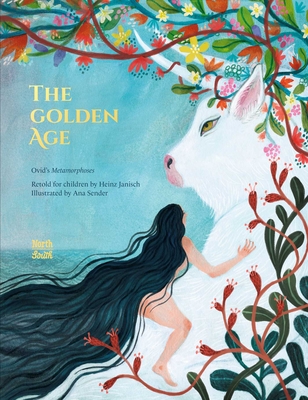



Ovid's Metamorphoses is one of the most influential works of Western literature, inspiring artists and writers from Titian to Shakespeare to Salman Rushdie. These are some of the most famous Roman myths as you've never read them before--sensuous, dangerously witty, audacious--from the fall of Troy to birth of the minotaur, and many others that only appear in the Metamorphoses. Connected together by the immutable laws of change and metamorphosis, the myths tell the story of the world from its creation up to the transformation of Julius Caesar from man into god.
In the ten-beat, unrhymed lines of this now-legendary and widely praised translation, Rolfe Humphries captures the spirit of Ovid's swift and conversational language, bringing the wit and sophistication of the Roman poet to modern readers.
This special annotated edition includes new, comprehensive commentary and notes by Joseph D. Reed, Professor of Classics and Comparative Literature at Brown University.


A modern translation of the ancient Roman poet Ovid's Remedies for Love--a witty and irreverent work about how to fall out of love
Breakups are the worst. On one scale devised by psychiatrists, only a spouse's death was ranked as more stressful than a marital split. Is there any treatment for a breakup? The ancient Roman poet Ovid thought so. Having become famous for teaching the art of seduction in The Art of Love, he then wrote Remedies for Love (Remedia Amoris), which presents thirty-eight frank and witty strategies for coping with unrequited love, falling out of love, ending a relationship, and healing a broken heart. How to Get Over a Breakup presents an unabashedly modern prose translation of Ovid's lighthearted and provocative work, complete with a lively introduction and the original Latin on facing pages. Ovid's advice--which he illustrates with ingenious interpretations of classical mythology--ranges from the practical, psychologically astute, and profound to the ironic, deliberately offensive, and bizarre. Some advice is conventional--such as staying busy, not spending time alone, and avoiding places associated with an ex. Some is off-color, such as having sex until you're sick of it. And some is simply and delightfully weird--such as becoming a lawyer and not eating arugula. Whether his advice is good or bad, entertaining or outrageous, How to Get Over a Breakup reveals an Ovid who sounds startlingly modern.






Ovid's epic poem--whose theme of change has resonated throughout the ages--is one of the most important texts of Western imagination, an inspiration from Dante's times to the present day, when writers such as Salman Rushdie and Italo Calvino have found a living source in Ovid's work. Charles Martin combines a close fidelity to Ovid's text with verse that catches the speed and liveliness of the original. Martin's Metamorphoses will be the translation of choice for contemporary readers in English. This volume also includes endnotes and a glossary of people, places, and personifications.

The first taste I had for books came to me from my pleasure in the fables of the Metamorphoses of Ovid. For at about seven or eight years of age I would steal away from any other pleasure to read them, inasmuch as this language was my mother tongue, and it was the easiest book I knew and the best suited by its content to my tender age. -Michel de Montaigne
P>Ars Amatoria; or, The Art of Love (2 AD) is an instructional poem by Ovid. Divided into three books, Ars Amatoria; or, The Art of Love was immensely popular-if a little controversial-in its time, and has survived numerous charges of indecency over the centuries. For the modern reader, it should prove a surprisingly relatable work on intimacy from an author of the ancient world. Although it has been argued that the publication of this work led to Ovid's exile in 8 AD, it remains unlikely that the poet was banished for anything other than political reasons having to do with succession.At times serious, at others humorous, Ars Amatoria; or, The Art of Love uses a mix of down-to-earth examples and relatable references to mythology in order to offer salient advice for the reader longing for love. Far from a valuable artifact of classical literature-which it is, in part-Ovid's work is a wonderfully straightforward textbook on all aspects of human relationships. Topics include etiquette, remembering birthdays, avoiding unhealthy jealousy, being open to older and younger lovers, and nurturing honesty. On sex, Ovid suggests a careful selection of positions according to comfort and physique, ultimately recommending that love-making be done in a way that pleasures all parties involved. Ars Amatoria; or, The Art of Love, although frequently tongue-in-cheek, is an earnest and effective attempt to enlighten and encourage its readers to partake-responsibly-in one of life's greatest pleasures.
With a beautifully designed cover and professionally typeset manuscript, this edition of Ovid's Ars Amatoria; or, The Art of Love is a classic work of Roman literature reimagined for modern readers.

. . . Humphries has rendered (Ovid's) love poetry with conspicuous success into English which is neither obtrusively colloquial nor awkwardly antique. --Virginia Quarterly Review

Written between A.D. 2 and 8, Ovid's long poem the Metamorphoses gave to a great number of Greek and Roman myths the form in which they are known today. Now David Slavitt, translator of the widely acclaimed Ovid's Poetry of Exile, has fashioned a splendid new English verse translation of what is perhaps the best-known work of one of western civilization's major's poets. In Slavitt's freely inventive but emotionally accurate renderings, the voice of Ovid speaks again to a new generation of readers.


This simple, utilitarian edition offers sixth-form and undergraduate students an introduction to the enchanted, sometimes violent, often sad, often funny world of the Metamorphoses. Book III is ideal in this respect, for it possesses a homogeneity unusual among the fifteen books of the poem and follows the fortunes of the royal house of Thebes in episodes which are related at some length, allowing the reader to savour the individual quality of each story and fix its 'dramatis personae' in mind and memory. The brief introduction places the book in its ancient context. Notes serve primarily to aid comprehension of the Latin but also give aesthetic and antiquarian information. A vocabulary is included.


This work has been selected by scholars as being culturally important, and is part of the knowledge base of civilization as we know it.
This work is in the public domain in the United States of America, and possibly other nations. Within the United States, you may freely copy and distribute this work, as no entity (individual or corporate) has a copyright on the body of the work.
Scholars believe, and we concur, that this work is important enough to be preserved, reproduced, and made generally available to the public. We appreciate your support of the preservation process, and thank you for being an important part of keeping this knowledge alive and relevant.

This volume brings together some of Ovid's most famous works on love and beauty, translated into English by the celebrated poet John Dryden. Widely regarded as one of the greatest English poets of all time, Dryden's translations capture the essence of Ovid's works and make them accessible to a new generation of readers.
This work has been selected by scholars as being culturally important, and is part of the knowledge base of civilization as we know it.
This work is in the public domain in the United States of America, and possibly other nations. Within the United States, you may freely copy and distribute this work, as no entity (individual or corporate) has a copyright on the body of the work.
Scholars believe, and we concur, that this work is important enough to be preserved, reproduced, and made generally available to the public. We appreciate your support of the preservation process, and thank you for being an important part of keeping this knowledge alive and relevant.

There is nothing constant in the universe, all ebb and flow, and every shape that is born bears in its womb the seeds of change. - Ovid
A faithful study of the liberal arts humanizes character. - Ovid
History is not the study of the past; it is the study of change. - Yuval Noah Harari.
Ovid's Metamorphoses is a sweeping epic describing the transformations that created his world. He begins with the creation of the world. He ends with the assassination and deification of Julius Caesar about 50 years before the completion of the Metamorphoses.
Ovid weaves together over two hundred and fifty myths of gods and humans into a continuous story, including the Trojan War, Pyramus and Thisbe, Perseus and the Gorgon, Pluto and the Proserpina, Arachne and Minerva, Jason and the Golden Fleece, Hercules and Cerberus, OEdipus and the Sphinx, Theseus and the Minotaur, D dalus and Icarus, Pygmalion's statue, Midas's golden touch and Romulus building Rome. The Metamorphoses mentions all the main gods, goddesses, and heroes. It contains stories from The Iliad, The Odyssey and The Aeneid and the only flood story in Greco-Roman mythology. It is a truly comprehensive work; perhaps the most accessible of the classics.
Metamorphoses is vast and complex yet light and lively. It is an engrossing exploration of human nature, the power of love, the threat of violence and the world's ever-changing nature. Ovid revels in the enormous variety of the physical world and the vagaries of human psychology and has produced this delightful work for the reader to dip into or read from beginning to end. This edition, designed for the reader, contains a summary of each myth and a detailed table of contents so you can go straight to any of the 250 stories. Numerous explanations enhance the modern reader's experience.
Publius Ovidius Naso (43 BC-AD 17/18), known as Ovid in English, was, together with Virgil and Horace, one of the three great Roman poets. His influence on literature and art in the Middle Ages and Renaissance is immense. His stories appear in the works of Chaucer, Dante, Bocaccio and Shakespeare and have inspired numerous Renaissance paintings and sculptures. He has enjoyed enormous popularity through the centuries, starting in his lifetime. He is best known for Metamorphoses.